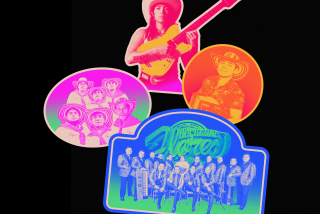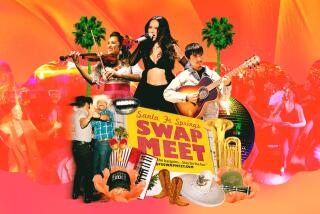Surf guitar strikes a chord in Peru
Few music styles are as indelibly linked to Southern California as surf guitar. Just a single chord, struck on a vintage Fender, with the right balance of ghostly tremolo and a rip current of reverb, can invoke an image of wood-paneled station wagons, board shorts and other endless summer cliches. It’s a recipe for instant nostalgia — even for those not yet born in the early ‘60s — a sound that music historian Barney Hoskyns perfectly describes as “a tincture of angst and heartache.”
For all its associations with the beach communities that stretch from Santa Barbara to San Diego, surf rock wasn’t purely born of Southern California. Tacoma, Wash.’s Ventures helped pioneer much of the instrumental guitar styles that later surf bands riffed on. Even the granddaddy of surf music — Dick Dale (who recently turned 74) — came to L.A. by way of Boston and Beirut first; the Lebanese music of his youth helped give his compositions a distinctive sound.
It seems apropos then that surf music wouldn’t be content to stay just in Southern California. Although the style caught on with garage bands across the U.S., its reach went much farther than that. The Beach Boys’ major label debut, “Surfin’ Safari,” could have been an apt description of how surf music would travel south, along the Pacific, and find an unlikely new home in the Amazonian and coastal cities of Peru.
Peruvian rock of the mid-’60s was inclusive from the start. From Colombia came the telltale, infectious two-step rhythm of cumbia, which became a flexible platform upon which everything from Cuban guaracha to Andean huayño to Spanish criollo traditions could be stacked. In 1968, Enrique Delgado of Lima’s Los Destellos introduced surf-inspired electric guitar, and the style known as cumbia peruana — Peruvian cumbia — began to take form.
Think of the amplified strum of surf guitar ripping across a percussive bed of conga slaps and the gurgling rasp of a guiro; it’s a sound from everywhere and nowhere at once. It’s tempting to call the blend “exotic,” but for decades, it has simply been the sound of popular music in Peruvian cities, especially among working-class migrants. (In fact, the style’s later name, chicha, carries with it the derogatory ring of middle-class disapproval, since chicha is also an alcoholic maize beverage mostly associated with the urban underclass.)
A wealth of compilations in the last four years have promoted Peruvian cumbia north of the equator, including two volumes of “The Roots of Chicha” by France’s Olivier Conan and “Cumbia Beat, Vol. 1,” released by Spain’s Vampisoul Records. These solid primers have recently given way to deeper explorations, including on Ranil y Su Conjunto Tropical’s “Ranil’s Jungle Party” and a brand new anthology, “El Sonido de Tupac Amaru,” both overseen by “Mike P” Pigott of Masstropicas Records.
I discovered cumbia peruana a few years back while searching for South American boogaloo and salsa records. Popular ‘60s and ‘70s albums by bands such as Los Destellos and the colorfully named Los Diablos Rojos are easy enough to procure online. What drew me in was how the style managed to borrow from any number of familiar elements from North, Central and South America and the Afro-Caribbean world yet piece them together in a unique synthesis with its own distinct character.
For example, in Colombia and Mexico, cumbia’s insistent rhythms are usually accompanied by rumbling bass drum and wheezing accordions. In contrast, Peruvian cumbia keeps the two-step beat, but otherwise its personality is far more cool and relaxed, less the sound of a sweltering dance hall and more the soundtrack for a plaza party at dusk.
Much of that feel is owed to that surf guitar presence, though it’s a chicken/egg debate over whether its signature pluck and twang somehow capture the sound of summer and sand or whether we’ve simply come to make that association through repeated exposure to surf anthems by Dale, Jan and Dean and the Beach Boys. Either way, that electrified sound, with its lightly jagged edge and sinuous reverb tendrils, colors and haunts much of the Peruvian cumbia you’ll find on these anthologies.
In his book “Waiting for the Sun: A Rock ‘n’ Roll History of Los Angeles,” music historian Hoskyns quotes the Pixies’ Frank Black describing surf rock as “egoless and anonymous,” which may explain why it travels so well. Even meshed with myriad musical traditions by bands from the Amazonian highlands of Junín to the Pacific port of Callao, the end result hardly feels “foreign.” The magic of surf guitar is that, wherever it goes, it brings the promise of Southern California’s utopian fantasy with it. Even far from its spiritual center, it somehow always manages to sound right at home.
More to Read
The biggest entertainment stories
Get our big stories about Hollywood, film, television, music, arts, culture and more right in your inbox as soon as they publish.
You may occasionally receive promotional content from the Los Angeles Times.










